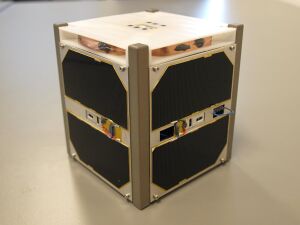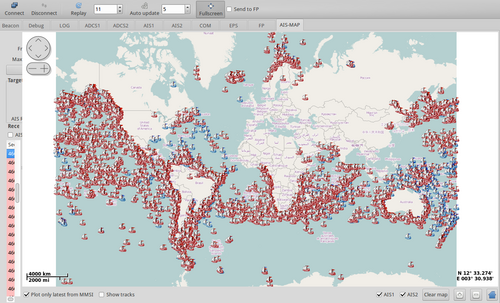Engineering:AAUSAT3
 AAUSAT3 flight model | |
| Mission type | Technology |
|---|---|
| Operator | Aalborg University |
| COSPAR ID | 2013-009B |
| SATCAT no. | 39087 |
| Website | www |
| Mission duration | 6 months planned |
| Spacecraft properties | |
| Spacecraft type | 1U CubeSat |
| Manufacturer | Aalborg University |
| Launch mass | 1 kilogram (2.2 lb) |
| Start of mission | |
| Launch date | 25 February 2013, 12:31 UTC[1] |
| Rocket | PSLV-CA C20 |
| Launch site | Satish Dhawan FLP |
| Contractor | ISRO |
| Orbital parameters | |
| Reference system | Geocentric |
| Regime | Low Earth |
| Perigee altitude | 775 kilometres (482 mi) |
| Apogee altitude | 793 kilometres (493 mi) |
| Inclination | 98.62 degrees |
| Period | 100.40 minutes |
| Epoch | 21 November 2013, 01:03:17 UTC[2] |
AAUSAT3 is the third CubeSat built and operated by students from the Aalborg University in Denmark . It was launched on 25 February 2013 from the Satish Dhawan Space Centre in India on a PSLV rocket (number C20). AAUSAT3 carries two AIS receivers as the main payload.
The educational objective
The primary purpose of satellite construction at Aalborg University is to give the students engineering experience beyond what is normally achieved within a master's degree program. The design, implementation, and manufacturing were carried out by students, with only two exceptions: the manufacturing of the mechanical structure (carried out by the department workshop in alu7075), and the raw non-mounted PCBs.
The scientific objective
The purpose of the satellite project was to find out if it was possible to receive AIS signals from a 1U CubeSat.
History
Student satellite activities at Aalborg University (AAU) started in 2003 as a result of AAU's involvement in the first pure Danish research satellite, Ørsted, which was successfully launched in 1999.
AAUSAT3's predecessors were AAU CubeSat (launched 2003), and AAUSAT-II (launched 2008).
Students from AAU also participated in SSETI EXPRESS (launched 2005), a student satellite initiative by ESA Education.
The construction of AAUSAT3 began in 2007.
Operations
 8124 AIS messages received in 11 hours on 8. March 2013. |
AAUSAT3 was launched on 25 February 2013 on PSLV C20. Operations were a success. 9,000 AIS messages were received on a daily basis and downloaded to the mission control center (MCC), located in Aalborg, Denmark. All subsystems were tested and running.
The first 100 days of operation were very successful. No degradation of the satellite was observed, all subsystems were working, and the primary payload – an AIS receiver – was working correctly. The mission continued.
Two critical situations occurred during the first 100 days:
28 February 2013 06:08: The last message for some days was received. During the previous 24 hours, battery voltage was decreasing, and temperature readings indicated that AAUSAT3 was steady pointing the side without solar cells towards the sun. During the last pass over Aalborg, it was observed that battery voltage was slowly decreasing.
The situation was discussed and analyzed during the day, and it was decided to instruct AAUSAT3 on all upcoming passes to switch off beacon mode because it was using power.
No further attempt was taken to make contact during the weekend in order to preserve and recharge the satellite's battery. All passes were supervised.
There was total silence until 4 March at 17:52 where the ground station in Aalborg requestes and received a beacon. The beacon showed an uptime of 1 day 19 hours, that everything was working, and that more than 7,000 AIS messages had been received. Everything went back to normal. The requested beacon also showed a high number of reboots, possibly due to low battery voltage.
Due to this event, AAUSAT3 was set to tumble slowly – 2 rotations for every 100-minute orbit – to avoid a repetition of the problem.
24 May 2013: The power system (EPS) on AAUSAT3 rejected multi-frame communication packages from the ground. During four passes (500 minutes), the students analyzed the situation and inspected the C source for the EPS server, and a solution was found. A new package was sent to AAUSAT3, and normal EPS operation was re-established. During the event, the rest of the satellite – due to the decentralized design – was working.
During the first 100 days, close to 800,000 AIS packages were received and downloaded.
10–11 June 2013: Two new software images for the SDR AIS receiver (AIS2) were uploaded. It took approximately 1.5 paths to upload a full AIS receiver image.
The satellite showed improvement and was newly capable of sampling and decoding in real time. First metrics showed a capacity of around 6,000 AIS messages per hour on average.
25 February 2014: One year up in space. AAUSAT3 was fully functioning, and AIS measurements were done on a regular basis. A ground station was established at Thule (Qaanaaq), Greenland, for extended download capacity. Energy production was stable but low, so the mission was interleaved with hours or days for charging batteries. New uploaded algorithms showed reception of approximately 8,000 messages per hour and real-time performance, which meant that decoding took less time than sampling and was carried out in parallel. Due to the ground station at Thule, it was possible to carry out real-time supervision, measuring and downloading at the same time. So only a few seconds after detection, the information was available in Aalborg at the MCC.
17 September 2014: The last message was received from the satellite.
Satellite subsystem strategy
AAUSAT3 was based on a decentralized concept with no dedicated master. The idea behind this approach was to achieve a modular satellite that, in many cases, would be able to function even when certain subsystems failed. For that reason, the must-have subsystems (EPS and COM) were designed to be simple and robust, whereas subsystems like AIS2 were by necessity more complex, with a concomitant higher failure rate.
The power system (EPS) acts as intelligent supervisor and watchdog. AAUSAT3 consists of several sub-systems:
| EPS | Electronic Power Supply | at90can128 | 8 MHz | FreeRTOS | 32kB add RAM | |
| COM | Communication Module | at90can128 | 16 MHz | FreeRTOS | 32 kB added RAM | ADF702x radio |
| ADCS1 | Attitude Determination and Control 1 | at90can128 | 8 MHz | FreeRTOS | 32 kB added RAM | detumbling |
| ADCS2 | Attitude Determination and Control 2 | arm 7 | x0 MHz | FreeRTOS | xx kB added RAM | determination and control |
| AIS1 | Automatic Identification System | at90can128 | 8 MHz | FreeRTOS | 32 kB added RAM | ADF702x for AIS receive |
| AIS2 | Automatic Identification System | BF537 | XXX MHz | μClinux | ADF702x for AIS receive | Receive all channels simultaneously |
| LOG | Onboard logging system | FreeRTOS | ||||
| FP | FlightPlanner | FreeRTOS |
On the ground segment, there were:
- CDH: Command and Datahandling System
- GND: Ground Station
- MCC: Mission Control Center
All internal and satellite-to-ground communication was carried out using CSP protocol.
Technical specifications
| Dimensions | 100 × 100 × 113 mm Cubesat standard |
| Mass | 800 grams |
| Expected lifetime | Minimum 1 month |
| Attitude determination system | Sun sensors, gyro sensors, magnetometers |
| Attitude control system | Magnetic coils |
| Power | Solar-cell panels located in satellite surface |
| Batteries | Li-ion 8.2V 2200 mAh |
| Power bus | 3.3 and 5V regulated |
| Antenna COM - UHF tx/rx | dipole (Be-Cu) |
| Antenna AIS (VHF) | dipole (Be-Cu) |
HAM information
- Callsign: OZ3CUB
- Up/downlink: 437.425 MHz
- Bit rate: 1200–19200 bit/s (default 2400, with operation at 9600 and 19200 tested successfully)
- CSP FM CW TLM
See also
- List of CubeSats
References
- ↑ McDowell, Jonathan. "Launch Log". Jonathan's Space Page. http://planet4589.org/space/log/launchlog.txt. Retrieved 21 November 2013.
- ↑ Peat, Chris (21 November 2013). "AAUSAT3 - Orbit". Heavens Above. http://www.heavens-above.com/orbit.aspx?satid=39087. Retrieved 21 November 2013.
External links

